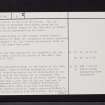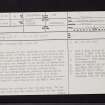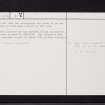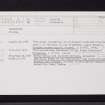Following the launch of trove.scot in February 2025 we are now planning the retiral of some of our webservices. Canmore will be switched off on 24th June 2025. Information about the closure can be found on the HES website: Retiral of HES web services | Historic Environment Scotland
Lochspouts
Crannog (Iron Age) - (Medieval)
Site Name Lochspouts
Classification Crannog (Iron Age) - (Medieval)
Canmore ID 40831
Site Number NS20NE 8
NGR NS 2880 0582
Datum OSGB36 - NGR
Permalink http://canmore.org.uk/site/40831
- Council South Ayrshire
- Parish Kirkoswald
- Former Region Strathclyde
- Former District Kyle And Carrick
- Former County Ayrshire
NS20NE 8 2885 0586
For logboat found in the loch, see NS20NE 25.
(NS 2876 0582) Crannog (NR) (site of)
OS 1:10000 map (1972)
A crannog was exposed by the lowering of the water level of Lochspouts prior to 1879, and partially excavated by Munro in 1880.It was shown to be approx 95ft in internal diameter, of wooden construction with a gangway to the shore. The finds are thought to be mainly of Roman-Iron Age date though some Medieval pottery and artifacts were also found (J Curle 1932). Roman finds include a melon bead, fragments of 2nd century Samian pottery, Romano-Celtic bronze dress-fasteners and possibly iron (A S Robertson 1970); other artifacts of stone, bone,deer horn, jet, bronze etc were also found and all were donated to the National Museum of Antiquities of Scotland (NMAS) (Acc Nos: HW 1-41).
Munro described the siting of the crannog thus; "On the N side of the Loch near the middle portion of the rocky ridge and a little to the W of the outlet. The low circular mound is overgrown with coarse grass and is so close to the present margin of the lake that it formed a peninsula easily approached by dry land".
Reservoir construction in 1882 largely removed Munro's excavated levels of 1880, but occupation evidence continued to a depth beyond 4 ft, and further multiperiod finds of bronze, jet and amber were made.
R Munro 1882; R Munro 1884; NMAS 1892; C M Piggott 1955.
The area has now been covered by the reservoir, but the crannog has been sited to the centre of the small loch shown on OS 6" 1859.
Visited by OS (JD) 29 November 1955
The arbitrary published siting to the centre of the loch, can be amended. Munro's siting description plus his informative frontpiece sketch can be supplemented by two photographs held by Mrs R Irvine of Lochspouts Farm (NS 285 059). These were taken in the early 1930's during a drought and show a wide area of the dry loch bed, of uniform appearance except for a roughly circular and slightly humped dark patch in an area scattered with stakes. Its deduced position largely agrees with Munro's siting and tallies exactly with the sketch. Mrs Irvine is not certain who took the photographs and knows of no one locally likely to have been present at the time.
From the above information the amended siting can confidently be placed in area NS 2885 0586. The reservoir now maintains a constant height of about 12ft in this vicinity.
Visited by OS (JRL) 12 June 1977
Note (1983)
Lochspouts NS 287 058 NS20NE 8
The remains of this crannog are submerged beneath the surface of the Lochspouts reservoir. It was first dug into before 1879, subsequently excavated by Munro in 1880, and partly demolished in 1882. Most of the finds recovered during these operations are in the National Museum of Antiquities of Scotland; they include objects and sherds of
pottery of Roman and medieval date.
RCAHMS 1983
(Munro 1882a, 1-18; Munro 1882b, 158-82; Munro 1884; Robertson 1970, Table iii).














